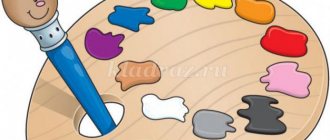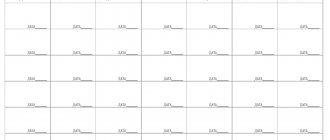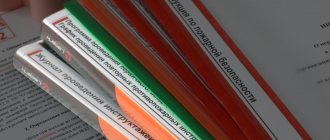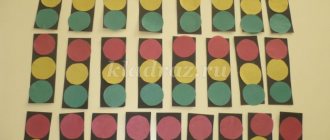"Health week in the middle group"
Author: Belousova Elena Anatolyevna
HEALTH WEEK PLAN
Monday – “Where is health hidden? Our assistant doctors" 04/01/2019
Target:
instilling in children a conscious attitude towards their bodies
| Ι half | % Morning exercises “Merry Cooks” Purpose: Preparation for vigorous activity, improvement of health. % Conversation: “What is health, how to preserve and increase it”, “What is posture.” Goal: to cultivate in children an interest in their own body, a conscious attitude towards their own health. % D. and: “Parts of the body” Goal: enrich the vocabulary, continue familiarization with the parts of the body, call and name them. “Vegetable garden on the window” Goal: to create conditions for caring for plants % Duty in a corner of nature. Goal: fostering a caring attitude towards nature, developing the ability to care for indoor plants (watering, loosening, wiping leaves) % “Healthy” Finger game “Orange”, “We are chopping cabbage”. Goal: to develop fine motor skills of children’s fingers. % Gymnastics for the eyes “Cheerful Dwarf” Goal: to teach children to concentrate their gaze on distant objects; develop observation and vigilance. |
| Independent activity | Board and printed games: lotto, dominoes, fold the picture, seasons, puzzles, mosaics, geometrics, lacing. Goal: development of thinking and memory, constructive abilities. |
| GCD | % The child and the world around him. “Aibolit visiting children” Goal: to continue to educate children in understanding the values of health, the need to be healthy, to lead a healthy lifestyle, to explain that in the spring the body needs food with vitamins, of which there are many in fruits and vegetables (S.N. Nikolaeva p. 60. Methods of environmental education in kindergarten). % Musical lesson (according to the music director’s plan) % Physical education in the air. Goal: Development of motor activity. Outdoor games: "Bird in the nest." |
| Walk | % Observation of icicles. Goals: develop horizons, introduce natural phenomena, cultivate interest in spring observations % Collective cleaning of the area from remaining snow and debris. Goal: to teach cleanliness and order in the area % Outdoor games “Who is the most accurate?”, “Catch up”. Goal: to develop independence in organizing outdoor games, accuracy, dexterity, and the ability to follow the rules. Independent games with external materials: Shovels, balls, skittles. |
| ΙΙ half | % Tempering procedures: Gymnastics after sleep “Funny Artists” Purpose: preparation for vigorous activity. % The plot-role-playing game “Hospital” - to give children an idea of the activities of different doctors (ENT, therapist, surgeon, to form emotional and cognitive communication of children with each other and with adults, to cultivate interest in medical professions, the desire to take care of their health. % Reading thin. literature:”, reading K. Chukovsky’s fairy tale “Doctor Aibolit”, looking at illustrations in books % Preliminary in music Playing music, moving to the beat of the music. Invite the children to dance together, repeating the movements of the teacher “Zvorobik” % Minute of safety: situational conversation with children on life safety “Dangerous objects”. Goal: to teach children to see that any object can carry a good and bad beginning. |
| Independent activity | S/r game “At the doctor’s appointment” Goal: to continue to form ideas about the medical profession. |
| Individual work | Games to develop fine motor skills " |
| Working with parents | Folder “Take care of your health. We follow the daily routine." Consultation “Drinking water and child health.” |
Tuesday – “Cleanliness is the key to health” 04/02/2019
Target:
Bring to the awareness of children the need and importance of maintaining hygiene procedures, maintaining cleanliness of the body, products, and premises.
| Ι half | % Morning exercises “Merry Cooks” Purpose: Preparation for vigorous activity, improvement of health. % Conversation: “Cleanliness is the key to health” Goal: to form in students an idea of the importance of observing the rules of personal hygiene for health; develop thinking, memory, attention; foster a culture of personal hygiene. % Game for attention: “Tops and Roots.” Goal: To ensure the development of children to classify vegetables according to the principle of edibility of the root and stem; develop attention, memory, develop interest in games. To promote the formation of children's ideas about the benefits and harms of food for the body. % Printed board game “Collect the picture” Goals: consolidate knowledge of color, shape, and the ability to assemble a whole from parts using a model; activate the dictionary. |
| Independent activity | Board games-laces for the development of fine motor skills. |
| GCD | FEMP 09.00. GEOMETRIC FIGURES. COUNTING TO 5. ACTIVE GAMES P.S. practice finding geometric shapes, develop attention, train counting to 5; develop speed, the ability to act on a signal. Develop attention, memory, logical thinking. Foster independence, curiosity, accuracy, encourage children's initiative. Enrich and activate the vocabulary: first, second, third, fourth, fifth, geometric shapes, circle, oval, square, triangle, rectangle, yellow, blue, red. Demonstration materials: pictures with 5 objects depicted on them; paper flowers, board, crayons. Razdat. materials: cards with numbers from 1 up to 5, strips of paper depicting rows of geometric shapes and colors, colored pencils (for each child) Method.techniques:Org.moment, game/exercise. “what geometric figure does this or that object look like”, game/exercise. “What geometric shapes does the drawing consist of?”, game/exercise “Color in the required object”, relay races, summing up. |
| Walk | % Wind Observation Targets: — continue to reinforce ideas about weather changes; - to form concepts about the wind and its properties; - learn to determine the direction of the wind. % P./i “Faster than the wind”, “Who is taller?” Goals: develop running speed; Learning to jump is easy. % Individual work: “The fastest.” Goal: to practice running, performing tasks to improve the ability to navigate in space (changing directions while running), and jumping (jumping on two legs). % Development of movements. Goal: to strengthen the ability to jump on one leg (right and left) |
| ΙΙ half | % Tempering procedures: Gymnastics after sleep “Funny Artists” Purpose: preparation for vigorous activity. % S/r game « Healthy food store” Goal: to consolidate students’ knowledge about healthy foods; develop volitional interaction, dialogical speech. Ball game “My funny ringing ball” Purpose: To strengthen children’s ability to hit the ball on the floor. % Preliminary work on fine art. Review of the lecture book, “lessons from Moidodyr”. Purpose: to clarify the pupils’ understanding of the formation of the group of groups, the algorithm for performing various hygiene procedures. % Construction of the “Pool” Goal: continue to consolidate the ability to use previously acquired knowledge in your work; independently organize your activities; independently set goal-result parameters; consolidate knowledge about the purpose of the pool; develop interest in constructive activities; to cultivate awareness of the importance of sport in a person’s life. % Minute of safety. |
| Independent activity | Games in the music corner, fun games: “Potatoes”, “Paints”. Goal: emotional mood. |
| Individual work | Development of mathematical concepts. Didactic game: “Wonderful bag.” Goal: development of tactile qualities; the ability to guess an object (cube, ball, cylinder). |
| Working with parents | Consultations, conversations, recommendations for parents: Consultation: “Formation of a healthy lifestyle in children.” |
Wednesday – “Vitamin Day” 04/03/2019
Target:
Help children understand that human health depends on proper nutrition, explain that food should not only be tasty, but also healthy.
| Ι half | % Morning exercises “Cheerful cooks” Purpose: Preparation for vigorous activity, improvement of health. % Conversation: “Vitamins in human life.” Goal: to develop students’ knowledge about the role of vitamins in human life; about what vitamins we can get from what foods. % Didactic games: “Find out by description”, “Place healthy foods on plates”, “Edible - inedible”, “Fold the picture” (fruits). Goal: To consolidate the names of vegetables and fruits, the ability to recognize them by touch and by description, to exercise the ability to differentiate vegetables and fruits. To form primary knowledge about edible and inedible foods. |
| Independent activity | Independent work on modeling “Vegetables on a plate” |
| GCD | “Profession-cook” Goal: to introduce children to the profession of a cook, his work activities, to develop the general concept of “profession” Edited by Kozina “lexical topics” p.106 |
| Walk | % Observation of the sun and its effect on plants and people. Objectives: to clarify children’s knowledge about the influence of the sun on the life of plants, animals, and people; develop observation and curiosity; talk about the effect of the sun on human health; develop an active vocabulary. % P\game “Grey Bunny”. goal: to develop physical activity while walking. % Individual work on movement development: jumping from heights. Goal: develop the ability to jump from heights. |
| ΙΙ half | % Tempering procedures: Gymnastics after sleep “Funny Artists” Purpose: preparation for vigorous activity. % Story/role-playing games: “Vegetable shop”, “Let’s treat the doll to compote.” Goal: To consolidate the names of vegetables and fruits, to cultivate a culture of behavior in public places. Develop the ability to sit correctly at the table and use cutlery. % Reading fiction: “What is good and what is bad.” V. Mayakovsky. Goal: to teach children to listen carefully to the text. % Leisure evening: “Doctor Vitaminkin.” Goal: to form the habit of a healthy lifestyle. % Experimental activity “Magic rose hips - I will save my health, I will help myself” - brewing rose hips. % Minute of safety. |
| Independent activity | Printed board games “Collect the picture.” Goal: to learn how to make a whole from parts. |
| Individual work | Word games: “Nature and us.” Goal: to systematize knowledge about the role of nature in human life. |
| Working with parents | % Screen “How to teach a child to eat vegetables and fruits.” % Consultation “Funny vegetables. Or about what to do with a child at home.” |
Thursday “Being friends with physical education means being healthy!” 04/04/2019
Target:
Forming an understanding of the need to take care of your health, protect it, learn to be healthy and lead a healthy lifestyle.
| Ι half | % Morning exercises “Merry cooks”. Goal: Preparation for active work, recovery. % Situational conversation “Why do you need exercise.” Goal: to continue to involve pupils in regular physical education; develop creativity in coming up with exercises for morning exercises; cultivate a competitive spirit. % Sensory development “What is round.” Goal: The ability to find round objects - a ball, the shape determines the action - a round one can roll. % Folklore (the nursery rhyme “Water, water”) Purpose: To remember the nursery rhyme, accompany the reading with hand movements. |
| Independent activity | Plot-role-playing game “Shop” (department “Sporting Goods”) Objective: To strengthen children’s ability to perform game actions in accordance with the plot of the game. |
| GCD | % Drawing (according to the art director’s plan) % Musical (according to the music director’s plan) % Physical education (hall) “Fun starts” (according to the plan of the physical education instructor) Goal: create a positive emotional mood, increase the motor activity of students; develop a sense of camaraderie and mutual assistance; bring joy from joint activities; develop an interest in physical education and a healthy lifestyle |
| Walk | % Conversation “What we breathe.” Objectives: to introduce the concept of “fresh air”, “oxygen”; talk about the factors that purify and pollute the air, about the importance of clean air for human health. % P/i “The fastest”, “Who is taller?”. Target : practice running, performing tasks to improve the ability to navigate in space (changing directions while running), and jumping (jumping on two legs). |
| ΙΙ half | % Gymnastics after sleep “Funny Artists” Purpose: preparation for vigorous activity. % Ball game « What sports do you know? Goal: To consolidate students’ knowledge about sports; develop dexterity when catching the ball; activate the dictionary. % Manual labor Album “Sport, sport, sport.” Pasting pictures of different sports on album pages. Goal: to clarify students’ understanding of why people engage in physical education and sports; develop speech. % Theatrical game (A. Barto “Girly Girl”) Purpose: education of cultural and hygienic skills. % Minute of safety. D/i “Helpful-harmful”. Goal: to consolidate children's knowledge about environmental factors affecting health |
| Independent activity | % Plot-role-playing game “Builders” (plot “Stadium”) Goal: to continue to consolidate the ability to use previously acquired knowledge in one’s work; independently organize your activities; independently set goal-result parameters; consolidate knowledge about the purpose of stadiums; develop interest in constructive activities; to raise awareness of the importance of sport in a person’s life |
| Individual work | % Familiarization with the surroundings. D/I “What items do you need to be clean?” Goal: formation of a group of people. |
Friday “To a fairy tale for health!” 04/05/2019
Target:
Forming a culture of a healthy lifestyle for pupils through fairy tales.
| Ι half | % Morning exercises “Cheerful cooks” Purpose: Preparation for vigorous activity, improvement of health. % Final conversation on the topic of the week: “How to preserve your health.” Goals: to systematize and consolidate the children’s knowledge acquired during the week. % Nature corner “Visiting Cipollino”. We look at the onion planted in the box. Task: Pay attention to how the onion has grown (green and large onion feathers), its amazing aroma, beneficial properties (before lunch, cut off a few onion feathers, chop them into the broth). % Physical education Goal: To induce in children a joyful mood and the ability to coordinate movements with the text. |
| Independent activity | %Iso. Coloring illustrations for the fairy tale “Moidodyr” with pencils. Goal: to develop fine motor skills of the hands, the ability to paint without going beyond the outline of the object. |
| GCD | % Application “Tree of Health” (team work) Goal: To continue to develop children’s knowledge about a healthy lifestyle. Select pictures depicting items necessary to maintain health. Carefully glue the pictures onto the tree silhouette |
| Walk | % Observation of poplar buds. Target : continue to get acquainted with the trees on the site; form the idea that a bud is a house for a leaf. % Outdoor games: “Run and jump”, “Who can run the fastest along the path.” Goal: to achieve good jumping technique when taking off, to practice running in a given direction. % Independent games of children with external material. |
| ΙΙ half | % Gymnastics after sleep “Funny Artists” Purpose: preparation for vigorous activity. % Role-playing game “Hospital” (plot “Traumatic Center”). Goal: To teach children to use their knowledge about traumatic situations in the game. To remember what happened to the animals in the fairy tale “Aibolit” and how the doctor treated them. % Household and household work “Little Helpers” Goal: Continue to teach children how to maintain order in the group room. Cultivate hard work. Introduce the proverb “Cleanliness is the key to health.” % Experimental activity “Parsley’s treats: snow and icicles.” Experiment 1 - Melting ice and snow. Experiment 2 - Filtration of melted and boiled water. % Construction games (building a garage for an ambulance). Goal: Continue to teach children how to build structures with ceilings and relate the size of the toy to the structure. % Minute of safety. Conversation “Every subject has its place.” Goal: discuss with children why it is very important that household items used by a person, tools, are stored in specially designated places. Consider problematic situations that may arise if this rule is violated. |
| Independent activity | % Independent motor activity. Goal: to develop pupils’ physical skills, speed, agility, coordination of movements, endurance; cultivate interest in joint gaming activities |
| Individual work | % Game-exercise “Pump” Goal: development of correct diaphragmatic breathing. |
Calendar planning on the topic: “We want to be healthy” in the senior group
Question:
What can you say about the skin?
Check yourself:
the skin is smooth, soft, and stretches easily.
Pay attention
— there are small folds on the skin.
Question:
What are folds in the skin for?
Experience I. _
To answer this question, do the following experiment:
a) place your left hand on the table, palm down; The folds on the top of the fingers are clearly visible. With your right hand, grab the folds of skin on any finger of your left hand. Try to bend your finger. It doesn't work. Release the folds and bend your finger. It bends freely;
b) lower your arm down and pay attention to the elbow on the outside of your arm. Bend and straighten your arm at the elbow several times.
Watch
, what happens to folds.
Explain
now the meaning of skin folds!
Check yourself:
folds in the skin are needed so as not to interfere with the movement of fingers, arms, legs and other parts of the body.
Experience II .
Examine the skin through a magnifying glass. A magnifying glass is a device whose main part is a magnifying glass. It magnifies all objects viewed through it.
Question:
What do we see through a magnifying glass?
Through a magnifying glass, small holes-pores and small hairs are visible on the skin. Oil is released onto the surface of the skin through the pores. Run your finger across your forehead. Then place your finger on the small glass. What did you see on the glass? That's right, a greasy stain.
check yourself
: This is the oil that has been released through the pores onto the skin of the forehead.
Fat lubricates the skin, makes it soft, and prevents it from drying out. Sometimes certain areas of the skin dry out. More often than others, the skin on the back of the hand dries out. This happens when a person washes his hands, doesn’t dry them enough with a towel, and goes outside. The wind dries the skin quickly, becomes very stretched and begins to peel. Sometimes cracks may appear on it, from which blood oozes. The person is in severe pain. Microbes can penetrate deep into the skin through cracks and cause various diseases (show picture.)
Therefore, after washing, be sure to dry both your hands and face. Don't go outside with wet hands and face.
Question:
What should you do if your skin is dry in some area?
That's right, you need to lubricate it with cream at night, preferably a special one for children. In addition to fat, sweat is released through the pores.
Questions:
What is it like? In what cases is sweat released?
Sweat is a product of the release of harmful substances and salts from the body. Sweat and oil remain on the surface of the skin. Dust sticks to them. This is how the body becomes covered with dirt. Microbes settle on dirty skin.
Question:
What happens to microbes on clean skin?
That’s right, germs die on clean skin. “Simple water and soap make germs lose their strength.” Therefore, be sure to keep your skin clean. At least once a week, you should wash your entire body with a washcloth and warm water and soap. In this case, the most hygienic is a shower, since it constantly washes the body with streams of clean water. In addition, a shower strengthens the body. After a shower, dry yourself well with a dry towel.



